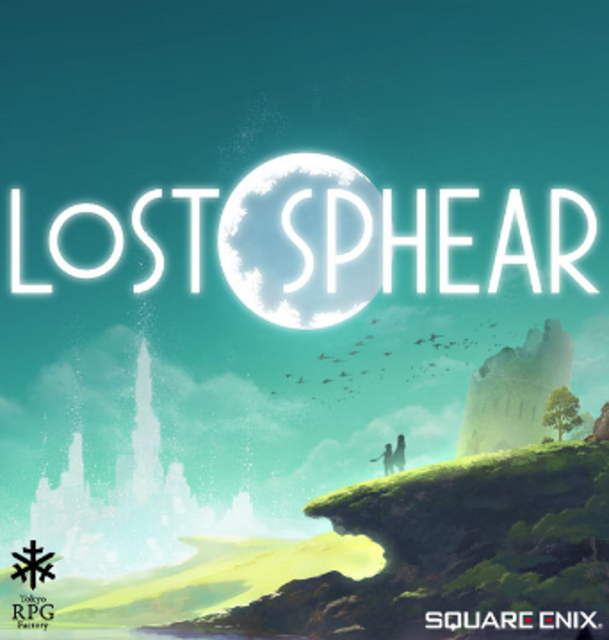Lost Sphear Review
Tokyo RPG Factory’s second outing does a far better job of capturing the feeling of the great JRPGs of old than its immediate predecessor but it still just lacks the soul of its illustrious ancestors.
Following the surprise success of Bravely Default on the 3DS Square Enix decided to hang its hat (not its best hat mind, a slightly tatty one it found at the back of a dusty closet) on a re-emerging market for tradtional JRPGs on modern hardware – thus Tokyo RPG Factory was born. Their first game, the gorgeously moribund I Am Setsuna met with a middling response. Whilst it’s poignant story was largely applauded it stumbled over its own cripplingly slow gameplay, obtuse battle system and outdated interface. It did however provide enough proof of concept for Square Enix to commission a spiritual successor; all of which brings us to Lost Sphear.
Even more so than I am Setsuna, Lost Sphear’s ties to the great JRPGs of old are tangible – a twist of Chrono Trigger in the improved battle system; a sprinkling of Final Fantasy VI in the mechanical ‘Vulcosuits’ you can pilot into battle and more than a little Final Fantasy IV in an interesting narrative focus on the moon. However, unlike I am Setsuna, Lost Sphear manages to stand on its own as a more accessible and enjoyable JRPG adventure for the modern day.
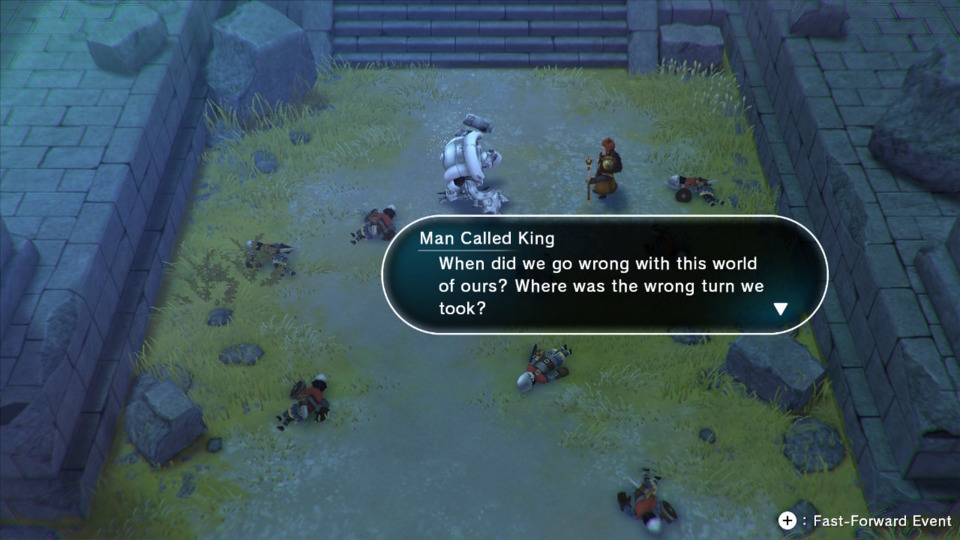
Taking on the role of Kanata (a young man with an unexplored backstory who is thrust into the role of saving the world – stop me if you’ve heard this one before) it’s revealed that only you have the power to combat the encroaching phenomenon of ‘becoming lost’. Objects, people and even places which become lost are struck from existence, leaving a white haze where they once stood and only by gathering the scattered memories of that place (be that by talking to people who remember it strongly, collecting them from around the world or battling monsters) can Kanata recombine them to return them to the material plane. It’s a fairly novel story, considering its heavy leanings on the old school, that doesn’t take too long to hit its stride and contains one or two interesting turns along the way. It kept me reasonaly engaged through to the credits and beyond, even if some of my delight was found in debating internally which of my favourite JRPGs a certain sequence reminded me of most.
As touched upon earlier the battle mechanics are much improved from I am Setsuna. The trappings of the traditional active time battle system are retained but significant quality of life improvements are made; you now have control over where your character moves to attack and areas of effect are no longer inexplicably left to total guesswork but are actually represented on screen. The ability to position your characters as you like introduces a light but pleasing level of strategy to some of the games more difficult battles; if an enemy has a devastating forward facing beam attack you can sweep your characters around to attack from the sides for example. It’s not a particularly complex mechanic but it adds a dynamism that the static ATB led systems of a traditional Final Fantasy can at times lack.
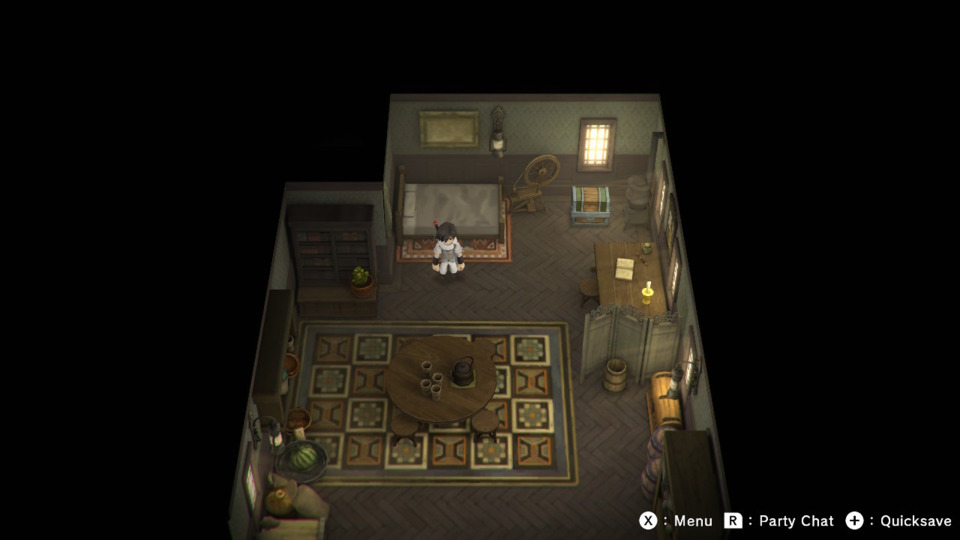
Battles are modified through the games unique ‘Artifact’ system that is introduced whilst exploring the overworld and restoring lost areas of land. Each Artifact that is restored to the map unlocks a new swathe of land and adds a gameplay modifier to either the entire gameworld or the (slightly nebulously defined) local area. These range from revealing enemy health bars to speeding up your ATB meter on a critical hit or significantly increasing your movement speed on the overworld map (in what I’m interpreting as a direct response to my ongoing complaints about the pace at which your characters crawled around the map in I am Setsuna). The Artifacts you choose also impart their benefits to enemies however and so picking Artifacts strategically introduces an interesting level of meta game to manipulate; is it worth taking the Artifact that means you never miss an attack again given that it also means you can never dodge an attack again either?
Skills are governed through Lost Sphear’s excellent ‘Spritnite’ system. Equipping a spritnite core grants a character the associated skill to use in battle, if that core is ever unequipped that skill is no longer available. As your characters level up they gain access to more spritnite slots and more spritnite cores can be condensed from the memories gathered on your journey. This allows you some flexibility in building your characters skill sets as you wish (although each characters skills generally make them better suited to one archetype or another be it tank, healer, mage etc.). Each skill can then be equipped with a ‘momentum spritnite’ which can add an elemental boost or status effect to attacks when ‘Momentum Mode’ is activated in battle.
Momentum in Lost Sphear, similarly to I am Setsuna, is built gradually when a character has a full ATB meter but does not act and can be triggered on any attack with a single button press at the cost of one full momentum node. The more a momentum spritnite is activated the more it’s effect ‘sublimates’ onto the skill spritnite in question and so skills can be gradually augmented with a number of effects throughout the course of the game until you have an instakill-poison-slow-sleep-stop AOE attack that covers the whole screen and can laugh maniacally as helpless mobs crumble before you. Momentum also plays into ‘counter spritnites’ which impart passive skills in battle if a threshold for accumulated momentum nodes is passed.
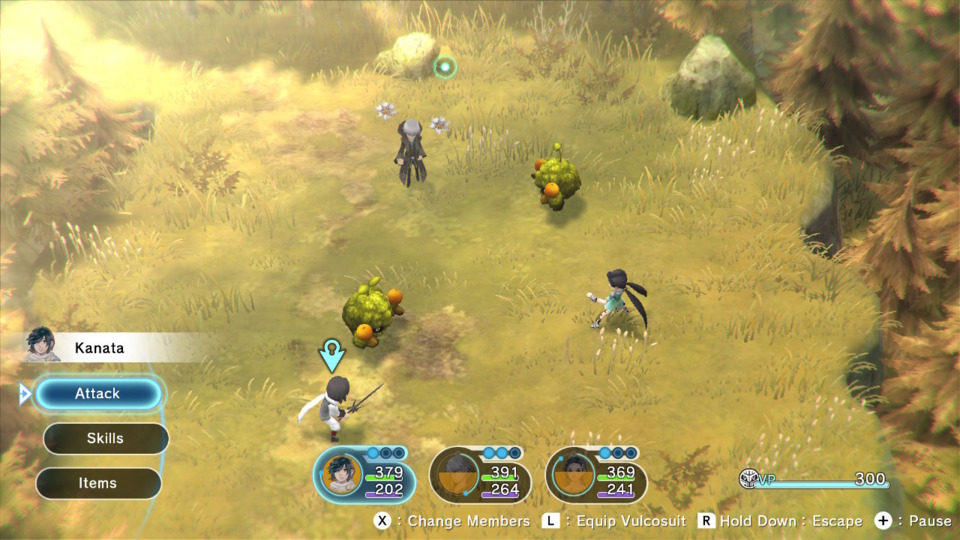
All these carefully tweakable options contribute to a multifaceted and genuinely fun progression system that allows for a surprising degree of uniqueness to your characters skill loadouts. Unfortunately, the game isn’t always excellent at onboarding some of these systems (skill sublimation particularly) and so that fun can take some finding. These interesting systems can also feel buried within the multitude of other systems the game presents from a simple weapon upgrade process to the core mechanic of the mech like ‘Vulcosuits’.
These can be equipped with the press of a button in or out of battle to use certain actions in the world or specialist skills in battle but the system can feel a little thin as each character only really gains one skill from their vulcosuit and the lengthy recharge on those skills means they’re likely to be popped only once a battle before your party runs out of ‘Vulco points’ (or VP, basically vulcosuit mana which is shared between the entire party). The worth of vulcosuits becomes increasingly obvious as you begin to encounter bigger, tougher bosses later in the game but their limitations still leaves them feeling like two thirds of a promising system unfortunately not fully realised.
Similarly to the less than impressive vulcosuits and the slightly shallow tutorialising of the games legion of systems, the overworld map feels too too lightly populated and unaturally manufactured. The two main continents are only lightly peppered with small villages to visit outside of the capital cities and too many small islands that you can reach when you unlock further forms of transport (guess what – first you get a boat and then later you get an air… no I won’t spoil it) are entirely empty. Too often I restored a new swathe of the continent to find absolutely nothing new or interesting under the swirling white mist.
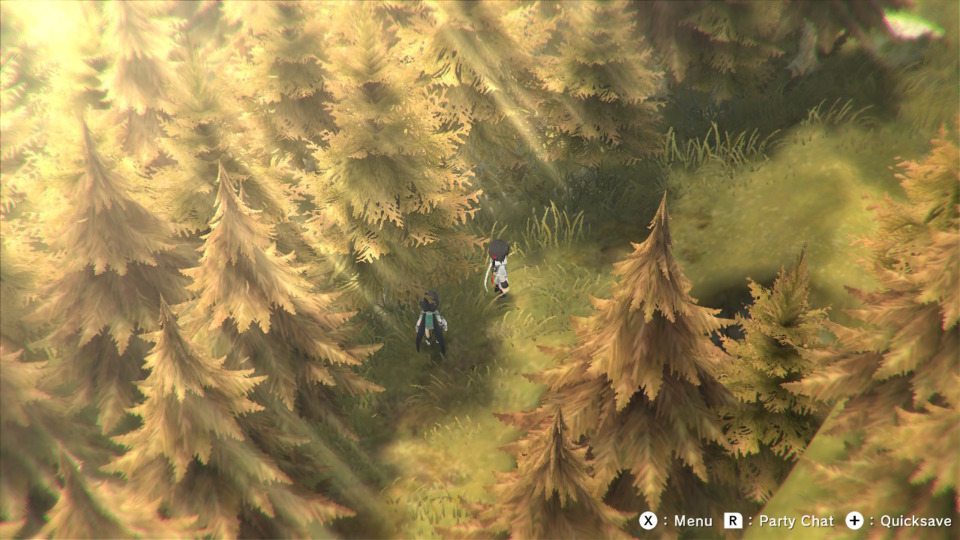
But none of these issues really play into my greatest problem with Lost Sphear. I enjoyed the story and was caught out by one or two of its big reveals and I like the cast of characters (even if they are largely a shallow collection of JRPG archetypes). The battle system manages to remain engaging throughout thanks to your level of character control, the supplementary Artifact effects and the frankly excellent skill system. The game even has a lot of little nuances in direction which I greatly appreciate; for example the multi-layered design of the games not oppressively long dungeons is extremely well constructed and hitting a switch on one level and seeing a bridge slide into place on the level below in the background is genuinely satisfying.
The problem is something more intangible than any of the mechanical issues the game has. In willingly invoking such colossal names of the genre as Chrono Trigger and the best 2D Final Fantasy games Lost Sphear lines itself up to be judged next to them and it’s just not as good. It’s not that it isn’t a good game in its own right, I genuinely like it a great deal, but it can’t escape the shadow of those that came before it and is left feeling somehow unsatisfying for it. Tokyo RPG Factory have rolled another game off the line, constructed from all the parts that should on paper make a great traditional JRPG and for most intents and purposes it is, but by trying to chase a blueprint of those great games it fails to capture something that can’t be turned out by a factory line; their soul.
